The hook lifts and skip loaders market is estimated to be valued at USD 3.2 billion in 2025 and is projected to reach USD 5.5 billion by 2035, registering a compound annual growth rate (CAGR) of 5.5% over the forecast period.
Analysis of the growth contribution index highlights the relative impact of key segments, regions, and end-use applications on overall market expansion, illustrating how incremental drivers combine to shape the long-term trajectory. In the early years, from 2025 to 2028, contributions are largely driven by municipal waste management and commercial construction sectors, with moderate adoption in industrial logistics. Between 2029 and 2032, higher growth contributions are observed from emerging economies where urbanization and infrastructure development increase demand for flexible and efficient waste handling solutions.
Technological enhancements, including hydraulic efficiency, automated control systems, and fuel-optimized engines, further strengthen the growth contribution index during this period. A minor moderation in contribution is noticed around 2033–2034, influenced by market maturity in developed regions and extended fleet lifecycles, yet overall adoption remains resilient. By 2035, growth contributions are reinforced by rising investment in smart waste management, private-public partnerships, and expanding industrial applications, ensuring balanced momentum across multiple drivers.
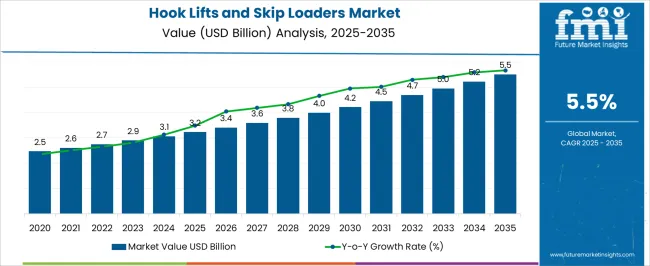
| Metric | Value |
|---|---|
| Hook Lifts and Skip Loaders Market Estimated Value in (2025 E) | USD 3.2 billion |
| Hook Lifts and Skip Loaders Market Forecast Value in (2035 F) | USD 5.5 billion |
| Forecast CAGR (2025 to 2035) | 5.5% |
The hook lifts and skip loaders market is shaped by five interconnected parent segments, each contributing to overall demand and growth. The waste management sector holds the largest share at 40%, as municipal solid waste, recyclables, and construction debris require efficient, flexible vehicles for collection and disposal in urban areas. The construction and demolition (C&D) industry contributes 30%, with hook lifts and skip loaders essential for transporting construction materials and debris, supporting rapid infrastructure development and urban expansion. The recycling industry accounts for 15%, driven by the need to collect, transport, and manage recyclable materials in alignment with circular economy initiatives.
The industrial sector holds 10%, where these vehicles facilitate the movement of bulk materials and waste within manufacturing facilities, enhancing operational efficiency. Finally, the municipal services segment represents 5%, encompassing public sector applications that rely on reliable waste and materials handling solutions. Collectively, the waste management, C&D, and recycling sectors account for 85% of overall demand, highlighting that urban sanitation, construction activities, and sustainable material handling remain the primary growth drivers, while industrial and municipal applications provide steady, complementary demand across regions globally.
The hook lifts and skip loaders market is experiencing strong growth, driven by the increasing demand for efficient waste management and construction logistics solutions. Expansion of urban infrastructure, industrial development, and large-scale construction projects are stimulating the adoption of these material handling systems. The market growth is being influenced by the versatility and adaptability of hook lifts and skip loaders, which enable rapid loading, unloading, and transportation of bulk materials across construction sites and waste management operations.
Rising labor costs and the need to enhance operational efficiency are encouraging companies to integrate mechanized lifting and transport solutions. Additionally, regulatory frameworks promoting sustainable waste management and safe construction practices are contributing to market expansion. The adoption of advanced hydraulic systems, improved chassis designs, and modular container compatibility is enhancing operational efficiency and safety.
As industries focus on reducing downtime and optimizing resource utilization, hook lifts and skip loaders are expected to remain critical solutions in construction and waste handling operations Continuous innovation and expanding applications in diverse industrial sectors are paving the way for long-term market growth.
The hook lifts and skip loaders market is segmented by product, application, and geographic regions. By product, hook lifts and skip loaders market is divided into hook lifts and skip loader. In terms of application, hook lifts and skip loaders market is classified into construction, agriculture, municipalities, forestry, and others. Regionally, the hook lifts and skip loaders industry is classified into North America, Latin America, Western Europe, Eastern Europe, Balkan & Baltic Countries, Russia & Belarus, Central Asia, East Asia, South Asia & Pacific, and the Middle East & Africa.
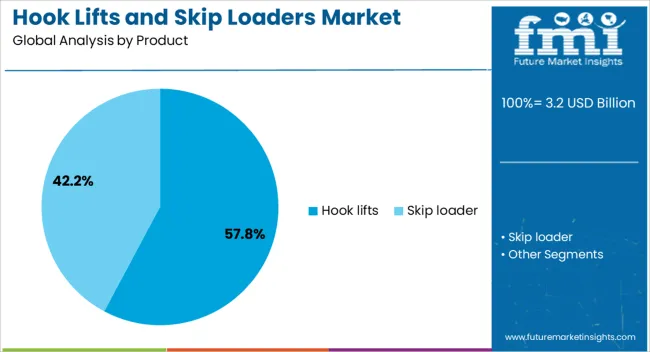
The hook lifts product segment is projected to hold 57.8% of the hook lifts and skip loaders market revenue share in 2025, positioning it as the leading product type. Its leadership is being driven by its ability to provide rapid and flexible loading and unloading of containers without the need for additional lifting equipment.
This mechanized efficiency reduces operational time and labor requirements, which is particularly valuable in construction, logistics, and waste management operations where speed and reliability are critical. The segment benefits from modular container compatibility, enabling operators to handle multiple types of loads with a single vehicle platform.
Advanced hydraulic systems and reinforced chassis designs are being adopted to improve durability, safety, and ease of operation, reinforcing the preference for hook lifts over alternative material handling solutions Additionally, the segment’s scalability and adaptability for various payload capacities are making it suitable for both small and large enterprises, supporting widespread market adoption and maintaining its dominant revenue share in the global market.
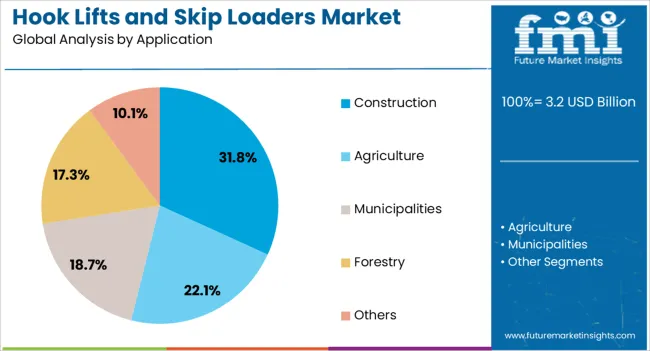
The construction application segment is expected to account for 31.8% of the hook lifts and skip loaders market revenue share in 2025, establishing itself as the leading application area. This growth is being driven by the increasing volume of construction projects worldwide, where efficient material handling and debris removal are essential for project timelines and cost optimization. Hook lifts and skip loaders are being used extensively for transporting building materials, rubble, and construction waste, providing operational flexibility and reducing the reliance on manual labor.
The ability to quickly switch between containers and load types enhances productivity and reduces equipment downtime on busy construction sites. Regulatory requirements for safe waste disposal and streamlined construction operations are further encouraging adoption.
Technological advancements, such as enhanced hydraulic lifting systems and improved vehicle maneuverability, are improving safety and operational efficiency, which reinforces the segment’s leading position As urbanization and infrastructure development continue globally, the construction sector is expected to remain the primary driver of demand for hook lifts and skip loaders in the coming years.
The hook lifts and skip loaders market is growing due to rising demand for efficient, flexible, and high-capacity waste and material handling solutions. Regulatory standards and safety compliance drive adoption of emission-compliant, durable, and operator-friendly vehicles. Technological advancements in hydraulics, automation, and telematics enhance efficiency, reliability, and productivity. Urban development, industrial expansion, and infrastructure projects support market growth, while government initiatives and fleet modernization programs promote adoption. Manufacturers focus on modular designs, low-maintenance systems, and adaptable configurations to meet evolving end-user requirements.
The hook lifts and skip loaders market is growing steadily due to increased demand for efficient waste collection and bulk material handling solutions. Municipal authorities, construction companies, and industrial sectors prefer these vehicles for rapid loading, unloading, and transport of waste, debris, and recyclables. The flexibility to handle multiple container sizes and types enhances operational efficiency. Growing urban development, commercial construction, and industrial projects are driving adoption. Features such as hydraulic lifting systems, safety mechanisms, and high payload capacity reduce labor requirements and improve productivity, making hook lifts and skip loaders a critical solution for modern waste management and material transport operations.
Regulatory frameworks on emissions, occupational safety, and vehicle standards significantly impact market growth. Municipal and industrial operators must comply with local and international guidelines on vehicle emissions, noise levels, load handling, and operator safety. Compliance ensures environmental responsibility, reduces liability risks, and enhances operational efficiency. Government initiatives promoting modernized waste management fleets encourage adoption of eco-friendly and compliant vehicles. Manufacturers are focusing on emission-compliant engines, durable hydraulic systems, and certified safety features to meet regulatory requirements. Adherence to these standards builds trust with clients and supports long-term market expansion in both developed and emerging regions.
Technological innovations in hydraulics, automation, and chassis design are driving market expansion. Modern hook lifts and skip loaders feature automated container handling, GPS-based route optimization, telematics for fleet monitoring, and advanced safety systems. Improved load distribution, corrosion-resistant materials, and low-maintenance components enhance durability and reduce operating costs. Modular designs and adaptable configurations allow operation across diverse industries, including municipal waste, construction, and recycling. Manufacturers invest in research to enhance lifting capacity, reduce fuel consumption, and provide operator-friendly controls. These innovations increase operational efficiency, minimize downtime, and improve overall productivity for fleet operators.
The market is fueled by increasing urban infrastructure projects, industrial expansion, and construction activities. Municipal authorities, contractors, and private operators are upgrading fleets to handle rising volumes of waste and materials efficiently. Large-scale residential, commercial, and industrial projects require flexible and high-capacity vehicles capable of managing diverse loads. Public-private partnerships and government initiatives for smart city and sanitation projects are creating consistent demand. Investments in fleet modernization, maintenance programs, and operator training support the adoption of hook lifts and skip loaders. Expansion of industrial parks, commercial hubs, and urban development initiatives further strengthens market growth globally.
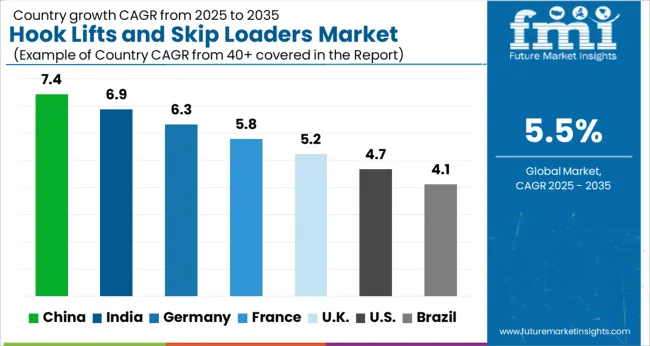
| Country | CAGR |
|---|---|
| China | 7.4% |
| India | 6.9% |
| Germany | 6.3% |
| France | 5.8% |
| UK | 5.2% |
| USA | 4.7% |
| Brazil | 4.1% |
The global hook lifts and skip loaders market is projected to grow at a CAGR of 5.5% from 2025 to 2035. China leads expansion at 7.4%, followed by India at 6.9%, Germany at 6.3%, the UK at 5.2%, and the USA at 4.7%. Growth is supported by increasing demand for efficient waste management solutions, expanding municipal fleets, and rising industrial applications requiring versatile material handling. China and India drive production and adoption due to rapid urbanization and infrastructure development, while Germany, the UK, and the USA focus on advanced hydraulic systems, durable chassis designs, and compliance with emission and safety standards. The analysis covers over 40 countries, with the leading markets detailed below.
The hook lifts and skip loaders market in China is projected to grow at a CAGR of 7.4% from 2025 to 2035, driven by expanding municipal solid waste management initiatives and industrial logistics requirements. Rapid urbanization, increasing construction activity, and government-backed waste collection modernization programs are creating demand for high-capacity, durable, and fuel-efficient hook lift and skip loader trucks. Manufacturers are focusing on hydraulic system innovations, modular chassis designs, and automation features to enhance loading efficiency, safety, and operational flexibility. Collaborations with global technology providers facilitate integration of telematics, route optimization, and maintenance monitoring systems. Growing awareness of sustainable waste management practices and industrial recycling programs further boosts adoption across urban centers and industrial hubs.
The market in India is expected to grow at a CAGR of 6.9% from 2025 to 2035, supported by rising municipal and industrial waste volumes and increased adoption of mechanized waste collection equipment. Hook lifts and skip loaders are increasingly deployed in urban waste management, construction, and industrial logistics to improve efficiency and reduce labor dependence. Manufacturers are introducing vehicles with hydraulic automation, GPS-enabled telematics, and modular chassis for diverse load capacities. Government initiatives under smart city programs and waste-to-energy projects are boosting market penetration. Partnerships between domestic manufacturers and global technology suppliers ensure compliance with emission norms, operational safety, and performance reliability, strengthening adoption in municipal and private sectors.

Germany’s market is projected to grow at a CAGR of 6.3% from 2025 to 2035, driven by environmental regulations, demand for low-emission waste collection vehicles, and industrial logistics optimization. Municipalities and private operators increasingly adopt hook lifts and skip loaders with hybrid or electric powertrains, advanced hydraulic systems, and automated loading features. Innovations in lightweight chassis, telematics, and safety systems are enhancing operational efficiency and route optimization. Collaborations between German manufacturers and international technology partners support R&D for performance enhancement and emission compliance. Urban infrastructure modernization, recycling initiatives, and industrial logistics expansion further drive the market, making Germany a leading adopter of advanced hook lift and skip loader solutions.
The UK market is expected to grow at a CAGR of 5.2% from 2025 to 2035, shaped by stringent environmental standards, urban sanitation projects, and demand from industrial logistics operations. Hook lifts and skip loaders are increasingly adopted to replace aging fleets with higher-capacity, fuel-efficient, and operator-friendly vehicles. Manufacturers are focusing on hydraulic automation, modular design, and telematics for operational efficiency, route optimization, and safety compliance. Government support through fleet modernization programs and subsidies for low-emission vehicles is further boosting adoption. Industrial parks, waste recycling centers, and large-scale construction projects are driving demand for flexible and high-performance hook lift and skip loader solutions.
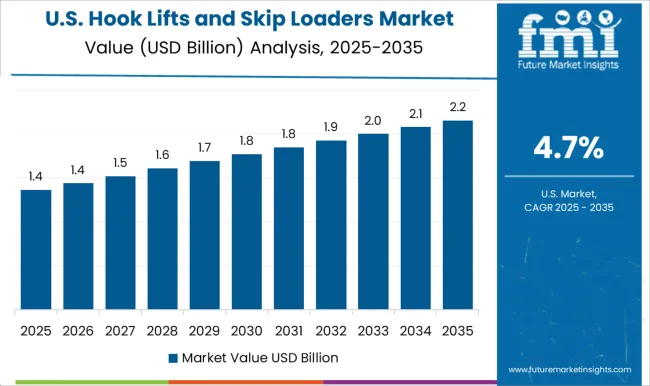
The USA market is projected to grow at a CAGR of 4.7% from 2025 to 2035, driven by municipal and industrial waste management modernization, construction activity, and industrial logistics requirements. Adoption is encouraged by the need for durable, high-capacity vehicles with advanced hydraulic systems, modular chassis, and automated loading capabilities. Manufacturers are introducing hybrid and electric options, telematics for route optimization, and maintenance monitoring systems to improve operational efficiency and sustainability. Industrial parks, recycling centers, and commercial construction projects create ongoing demand for flexible hook lift and skip loader solutions. Partnerships with technology providers and adherence to emission and safety standards further enhance adoption across municipal and private sectors.

Competition in the hook lifts and skip loaders market is shaped by lifting capacity, hydraulic efficiency, and operational versatility. Ampliroll Hooklift Systems leads with robust, modular solutions designed for heavy-duty waste management, construction, and industrial transport applications. B.O.B. Sistemi Idraulici S.p.A and Galbreath compete with advanced hydraulic systems and customizable hook lift configurations, emphasizing durability, ease of maintenance, and compatibility with multiple chassis types. Cargotec Corporation and Hiab AB differentiate through innovative hydraulic technologies, telematics-enabled monitoring, and safety-focused design for industrial and municipal applications.
Hyva Global B.V., Marrel SAS, and Meiller Group focus on high-quality hook lifts and skip loaders with multi-functionality, corrosion resistance, and enhanced load handling efficiency. Regional and mid-sized players such as Palfinger AG, Stellar Industries, SwapLoader USA Ltd, VDL Containersystemen BV, and West-Trans Equipment offer specialized solutions tailored for local construction, waste management, and municipal needs. Volvo Construction Equipment provides OEM-integrated systems, combining vehicle and lifting equipment design for optimized performance. Strategies across the market emphasize hydraulic reliability, modular adaptability, ease of retrofitting, and reduced operational downtime. Companies are investing in lightweight materials, safety automation, and telematics integration to improve efficiency and regulatory compliance. Partnerships with fleet operators, municipalities, and construction contractors support tailored solutions and aftermarket services.
Product brochure content is precise and technical. Hook lifts and skip loaders are offered with specifications on lifting capacity, reach, container compatibility, hydraulic pressure, cycle time, and chassis requirements. Safety features, including overload protection, locking mechanisms, and operator ergonomics, are highlighted. Installation guidelines, maintenance schedules, and retrofit options are detailed. Accessories such as control systems, telematics modules, and auxiliary hydraulic circuits are described, reflecting a market focused on durability, operational efficiency, and versatility for diverse industrial and municipal applications.
| Item | Value |
|---|---|
| Quantitative Units | USD 3.2 Billion |
| Product | Hook lifts and Skip loader |
| Application | Construction, Agriculture, Municipalities, Forestry, and Others |
| Regions Covered | North America, Europe, Asia-Pacific, Latin America, Middle East & Africa |
| Country Covered | United States, Canada, Germany, France, United Kingdom, China, Japan, India, Brazil, South Africa |
| Key Companies Profiled | Ampliroll Hooklift Systems, B.O.B. Sistemi Idraulici S.p.A, Cargotec Corporation, Galbreath, Galbreath Inc., Hiab AB, Hyva Global B.V., Marrel SAS, Meiller Group, Palfinger AG, Stellar Industries, SwapLoader USA Ltd, VDL Containersystemen BV, Volvo Construction Equipment, and West-Trans Equipment |
| Additional Attributes | Dollar sales by vehicle type and lifting capacity, share by application (waste management, construction, industrial) and region, growth trends, safety regulations, operational efficiency, emerging designs, and competitive positioning. |
The global hook lifts and skip loaders market is estimated to be valued at USD 3.2 billion in 2025.
The market size for the hook lifts and skip loaders market is projected to reach USD 5.5 billion by 2035.
The hook lifts and skip loaders market is expected to grow at a 5.5% CAGR between 2025 and 2035.
The key product types in hook lifts and skip loaders market are hook lifts and skip loader.
In terms of application, construction segment to command 31.8% share in the hook lifts and skip loaders market in 2025.






Our Research Products

The "Full Research Suite" delivers actionable market intel, deep dives on markets or technologies, so clients act faster, cut risk, and unlock growth.

The Leaderboard benchmarks and ranks top vendors, classifying them as Established Leaders, Leading Challengers, or Disruptors & Challengers.

Locates where complements amplify value and substitutes erode it, forecasting net impact by horizon

We deliver granular, decision-grade intel: market sizing, 5-year forecasts, pricing, adoption, usage, revenue, and operational KPIs—plus competitor tracking, regulation, and value chains—across 60 countries broadly.

Spot the shifts before they hit your P&L. We track inflection points, adoption curves, pricing moves, and ecosystem plays to show where demand is heading, why it is changing, and what to do next across high-growth markets and disruptive tech

Real-time reads of user behavior. We track shifting priorities, perceptions of today’s and next-gen services, and provider experience, then pace how fast tech moves from trial to adoption, blending buyer, consumer, and channel inputs with social signals (#WhySwitch, #UX).

Partner with our analyst team to build a custom report designed around your business priorities. From analysing market trends to assessing competitors or crafting bespoke datasets, we tailor insights to your needs.
Supplier Intelligence
Discovery & Profiling
Capacity & Footprint
Performance & Risk
Compliance & Governance
Commercial Readiness
Who Supplies Whom
Scorecards & Shortlists
Playbooks & Docs
Category Intelligence
Definition & Scope
Demand & Use Cases
Cost Drivers
Market Structure
Supply Chain Map
Trade & Policy
Operating Norms
Deliverables
Buyer Intelligence
Account Basics
Spend & Scope
Procurement Model
Vendor Requirements
Terms & Policies
Entry Strategy
Pain Points & Triggers
Outputs
Pricing Analysis
Benchmarks
Trends
Should-Cost
Indexation
Landed Cost
Commercial Terms
Deliverables
Brand Analysis
Positioning & Value Prop
Share & Presence
Customer Evidence
Go-to-Market
Digital & Reputation
Compliance & Trust
KPIs & Gaps
Outputs
Full Research Suite comprises of:
Market outlook & trends analysis
Interviews & case studies
Strategic recommendations
Vendor profiles & capabilities analysis
5-year forecasts
8 regions and 60+ country-level data splits
Market segment data splits
12 months of continuous data updates
DELIVERED AS:
PDF EXCEL ONLINE
Hooklift Trailer Market Size and Share Forecast Outlook 2025 to 2035
Boat Hook Market Growth - Trends & Forecast 2024 to 2034
Stair Lifts and Climbing Devices Market Analysis - Size, Share & Forecast 2025 to 2035
Platform Lifts Market Size and Share Forecast Outlook 2025 to 2035
Bariatric Lifts Market Size and Share Forecast Outlook 2025 to 2035
Dumbwaiter Lifts Market Growth - Trends & Forecast 2025 to 2035
Construction Lifts Market
Vertical Mast Lifts Market Analysis & Forecast by Product Type, Working Height, Capacity, End-user Industry, and Region Through 2035
Train Loaders Market Size and Share Forecast Outlook 2025 to 2035
Global Loaders Market
Bulk Bag Unloaders Market Size and Share Forecast Outlook 2025 to 2035
Compact Wheel Loaders Market Size and Share Forecast Outlook 2025 to 2035
Low Clearance Loaders Market Size and Share Forecast Outlook 2025 to 2035
Multi Attachment Loaders Market Size and Share Forecast Outlook 2025 to 2035
Europe Multi-Attachment Loaders Market - Size, Share, and Forecast 2025 to 2035
MET ex14 Skipping Treatment Market Size and Share Forecast Outlook 2025 to 2035
Android Automotive OS (AAOS) Market Size and Share Forecast Outlook 2025 to 2035
Anderson Cascade Impactor Market Size and Share Forecast Outlook 2025 to 2035
Andersen-Tawil Syndrome Treatment Market Trends - Growth & Future Prospects 2025 to 2035
Andro Supplements Market

Thank you!
You will receive an email from our Business Development Manager. Please be sure to check your SPAM/JUNK folder too.
Chat With
MaRIA